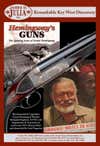Ernest Hemingway’s .577 Nitro Rifle Up For Auction
We may earn revenue from the products available on this page and participate in affiliate programs. Learn more › by...

We may earn revenue from the products available on this page and participate in affiliate programs. Learn more ›

by Phil Bourjaily
Another famous gun is going on the auction block. In March, James D. Julia’s in Maine, the house which previously sold Nash Buckingham’s Bo Whoop and Teddy Roosevelt’s A.H. Fox, will sell Ernest Hemingway’s .577 Nitro double. Hemingway took the massive single-trigger Westley Richards side-by-side on at least two safaris and shot a lion, a rhino and possibly a buffalo with it. It is expected to bring somewhere between $150,000 and $200,000.
If $200,000 is too rich for you, spend $40 on “Hemingway’s Guns,” (181 pages;shootingsportsman.com) by Silvio Calabi, Steve Helsly and Roger Sanger. The three have done a fine job of researching the guns owned by Ernest Hemingway. The book is full of interesting facts, lively anecdotes and an excellent selection of photographs. “Hemingway’s Guns” assumes no prior knowledge of firearms, so some of the gun writing is overly basic, but all in all it’s a great addition to any Gun Nut’s book collection and a whole lot cheaper than buying the rifle.
Each chapter covers a particular gun. We learn, for instance, that Hemingway ordered the action for his favorite rifle, the ’03 Springfield he shoots throughout “Green Hills of Africa,” from the Division of Civilian Marksmanship. The famous Col. Townsend Whelan hand-picked the barreled action for Hemingway’s rifle, which was then custom stocked and sporterized by the gunsmiths at Griffin & Howe.
There’s a chapter on the gun with which Hemingway killed himself, which was taken to a welding shop to be destroyed shortly after his death. The gun, variously reported to be a Boss, a Model 12, or a Bernadelli, was determined, through sleuthing by the authors, to be Hemingway’s W&C Scott pigeon gun . They were even able to find and photograph a few surviving fragments of the lockplate.
The .577 gets a colorful chapter to itself. The authors describe Hemingway’s unsuccessful attempt to use it to take the most dangerous game of all: a German U-boat. During WWII he outfitted his fishing boat Pilar with a radio, a bazooka, machine guns, and the .577. His plan – which was Hemingway-esque in the extreme — was to cruise the waters off Havana until a U-Boat surfaced to steal their supplies, as sometimes happened to small boats. Then Hemingway and the crew would open fire as two Basque jai alai players flung satchel charges down the submarine’s hatches. Hemingway never did bag his U-Boat, but he lived an eventful, tragically shortened life in the outdoors that is well chronicled in “Hemingway’s Guns.”